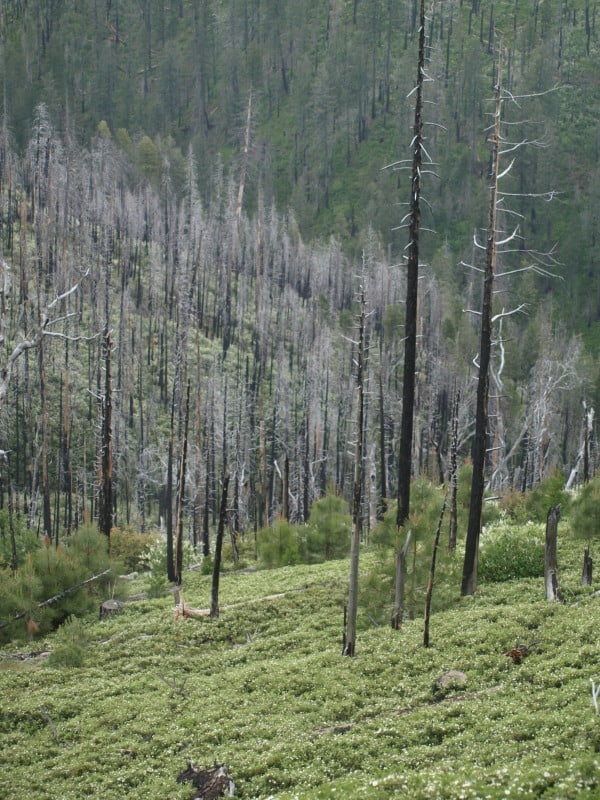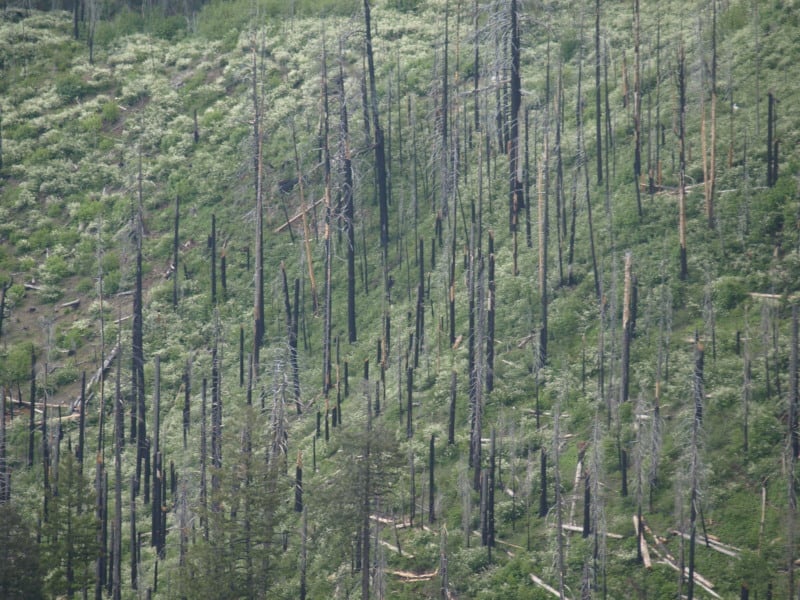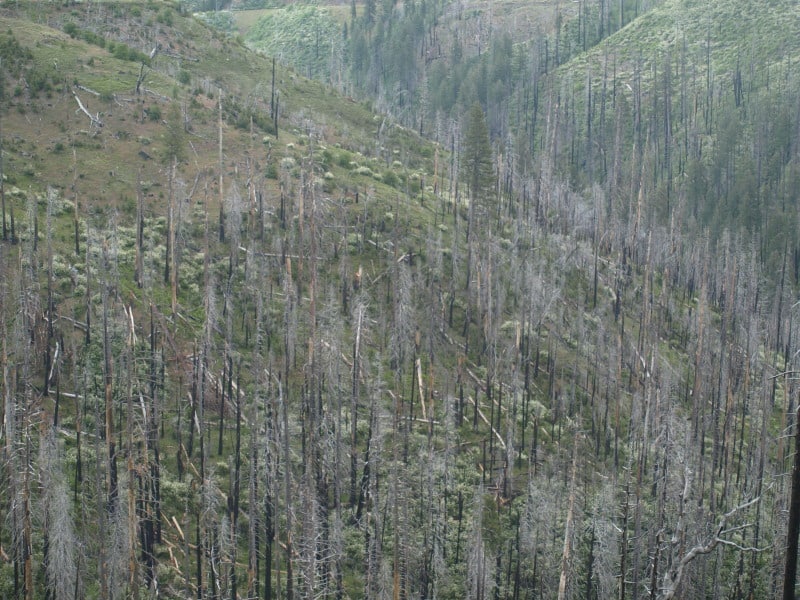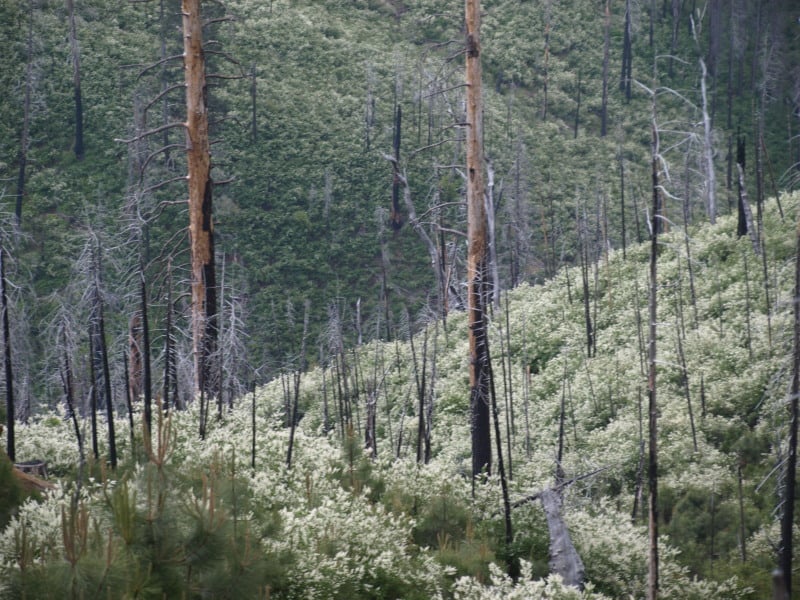With our discussions about burned forests and blackbacked woodpeckers, here are some views of the Power Fire, on the Eldorado National Forest. Initially, the wildfire seemed to be of mixed severity but, as the summer wore on, more and more insect mortality caused previously green trees to turn brown. After Chad Hanson took his appeal to the Ninth Circuit Court, this project was halted with about 75% of the dead trees cut. The court decided that not enough analysis was done regarding the blackbacked woodpecker, despite only 55% of the burned area in the project.
In this picture, seven years after it burned, most of those foreground snags were in a helicopter unit, with a fairly large stream buffer at the bottom. At least 5 times we marked additional mortality in that unit. Also important is the fact that we were cutting trees which still had green needles, using the new fire mortality guidelines of the time. As you can see, the density of snags should be quite sufficient in supporting multiple woodpecker families.
This patch of snags was clumped, below a main road and above a major streamcourse.
Another view of abundant snags within a cutting unit, and a protected streamcourse.
You can see that both large and small snags were left for wildlife. After 6 years, surely some snags have already fallen, as expected. Not every acre can, or should, have birds on every acre. Since this is predominantly a P. pine stand, the combination of high-intensity fire and subsequent bark beetles caused catastrophic losses of owl and goshawk habitat, including nest trees. You can also see that reforestation is, and will continue to be problematic, with all that deerbrush coming back so thick.




LH says ” As you can see, the density of snags should be quite sufficient in supporting multiple woodpecker families.” This statement is based on a very narrow snapshot in time. It ignores important ecological processes that play out over time and have a more profound influence on snag habitat over the long term. Larry (and the Forest Service) like to focus on the apparent pulse of snags created by fires, but this can lead us to erroneous conclusions.
Somewhat counterintuitively fires actually cause a long-term SHORTAGE of snags. One of the most significant and lasting effects of stand replacing disturbance such as fire, wind, or regeneration logging is to bring the process of snag recruitment to a virtual standstill for many decades. Even if snags are not removed by the disturbance, snags created by the disturbance will fall down over time and few if any snags are created. This results in a “snag gap” that has serious adverse consequences for habitat and many other ecological processes. The apparent abundance of large snags after a stand replacing disturbance masks a severe shortage of large snags in the future. If salvage logging removes commercial sizes snags, those are among the large dead trees that will remain standing the longest – those that have a chance to persist into (and help mitigate) the snag gap. So while fire creates a shortage of snags (snag gap), salvage logging makes a bad situation worse (exacerbates the snag gap).
In Congressional testimony in July 2004, Jerry Franklin said: “It is sometimes argued that following a stand-replacement fire in an old-growth forest that snags and logs are present in “excess” of the needs of the site, in terms of ecosystem recovery. In fact, the large pulse of dead wood created by the disturbance is the only significant input of woody debris that the site is going to get for the next 50 to 150 years—the ecosystem has to “live” off of this woody debris until the forest matures to the point where it has again produced the large trees that can become the source for new snags and logs (Maser et al. 1988).” Dr. Jerry F. Franklin, Professor of Ecosystem Studies, College of Forest Resources, University of Washington. July 15, 2004. TESTIMONY FOR THE RECORD ON OVERSIGHT HEARING ON “RESTORING FORESTS AFTER CATASTROPHIC EVENTS” BY HOUSE COMMITTEE ON RESOURCES, SUBCOMMITTEE ON FOREST AND FOREST HEALTH.
Most LRMPs that I am familiar with require that snag populations and snag recruitment be maintained through time, so the goal after a large fire (that brings snag recruitment to a halt) must be to recognize the existence of a future shortage of snags and manage the fire area to minimize the time period that there is a deficit of snags.
The snag gap is really exacerbated by salvage logging in three ways — first by the removal of any snags, second by targeting removal of the large and most persistent component of the snag population, and third by accelerating the rate that remaining snags fall and are lost from the snag population. Science from Idaho reveals that Ponderosa pine snags persist longer in unlogged areas. See Russell, R.E., Saab, V.A., Dudley, J.G., and J.J. Rotella. 2006. Snag longevity in relation to wildfire and postfire salvage logging. Forest Ecology and Management 232 (2006) 179-187. http://www.fs.fed.us/rm/pubs_other/rmrs_2006_russell_r001.pdf (“The predicted half-life of a ponderosa pine snag was 7-8 years in salvage logged plots and 9-10 years in unlogged plots.”)
There is a strong correlation between the diameter of the snag and the length of time it is likely to remain standing, so if salvage is going to avoid exacerbating the snag gap, salvage must be designed to retain all the large snags and only remove trees from smaller size classes.
Once again, Tree is cherrypicking and not looking at site specific information. Remember, it was Tree who supported putting BBW’s into dead Utah Forests, 500 miles outside of their range. If you knew more about the birds’ biology, you would know that BBW’s needs “fresh” snags, After about 6 years, the snags no longer contain what the birds want. It is a “changing of the guard” of what lives in the snags. Boring insects, which prefer the inner parts of a dead tree, are out of reach from birds, inhabiting the heartwood of the tree. Sometimes, the birds can stay longer, if there is a pulse of bark beetles, killing the fire’s survivors. That could only extend their stay for a few more years. Also, there is this fact that we leave multiple sizes of snags left for wildlife on salvage projects, as well as untouched snag patches. If Franklin doesn’t address the re-burn issue, he’s not telling the whole story. We have addressed all the BBW issues, providing PLENTY of viable snag habitat. We shouldn’t be trading goshawks and owl nesting habitats for dead forests.
I tend to think that the idea of managing forests solely for woodpeckers will fail. They have survived through a long period of time when salvage projects left almost zero snag habitat, due to aggressive policies. I have no doubt that they will do just fine with modern salvage practices on Forest Service lands. Once again, there is a conundrum going on here. If their populations are so small, then why do we need millions of acres of snag habitats?.
Larry,
1) Snags and dead trees are valuable for more than black-backed woodpeckers – e.g., other species use different stages of decay, substrate for plants and invertebrates, carbon storage, soil building, nutrient capture/storage/release, thermal buffering, water storage, sediment capture, snow capture, spatial habitat partitioning. http://www.fs.fed.us/psw/publications/documents/gtr-181/068_Marcot.pdf
2) It’s true that a variety of wildlife need snags of a variety of stages of decay, but “some” snags of “any” stage are better than no snags.
3) I’m not sure where you got the idea I was putting BBWP in Utah. You must have misread something I wrote.
4) You did not respond to my key point – that salvage logging exacerbates the “snag gap.”
5) You criticize the messenger, instead of the substance of the argument.
6) You provide no support for your assertions about “plenty of snags.” For which species? For how long? What about after most of the snags fall?
7) And reburn – we’ve been over this before. It affects only a small subset of burned forests during the period shortly after a previous burn, and you can’t justofy salvage logging based on a prediction of reburn because you don’t know where that small subset might be.
Reply to 1) Plenty of snags of multiple sizes are being left, both outside and inside of cutting units. Most of the smallest merchantable trees (above 10″ dbh) are cut, if they haven’t decayed from delays. Where I live, fuels and re-burns are the number one concern on salvage sales.
Reply to 2) No one is proposing to take down all the snags, Tree. In my pictures, you can see how many snags are still standing, including some very large ones.
Reply to 3) I posted pictures of a salvage project in Utah, and you said it would have been a good opportunity to get BBWP’s on the land. You must not have read the title of posting, I guess.
Reply to 4) I did respond, saying that plenty of snags of different sizes were being left. No, this is not your grandfather’s version of salvage logging. The snag gap is pretty trivial, where I live. Snags just don’t last too long around here, at least in vertical formation. The Tahoe Basin is a very good example of perfectly preserved snags that died and fell down in the 1990’s. It is so dry during the summer, rot works at a very slow pace. Much slower than human-enhanced wildfire occurrences.
Reply to 5) “After Chad Hanson took his appeal to the Ninth Circuit Court, this project was halted with about 75% of the dead trees cut.” That is not anywhere near a criticism. It is a simple, straightforward statement of fact.
Reply to 6) What can anyone do when all the snags fall?? It is inevitable and with re-burn always being a threat, all that fuel is now next to the ground, ready to devastate soils, impacting the land for a century, or more. Next time I go to Yosemite, I’ll make another stop at my Yosemite Foresta example, just to document those catastrophic effects, over time.
Reply to 7) My Foresta example ended up at 16,000 acres, despite days of water drops and hand crews, costing $17,000,000 to suppress. In the National Park! It was a perfect re-burn of 20 year old brush and massive fallen logs. There were some survivors from the original 1989 A-Rock Fire but, many perished in the re-burn. The soils damages seem to be quite significant, with very little organic matter in the decomposed granite. Somewhere in my Kodachrome slides is a pre-1989 picture of the Foresta area. Gotta get my slide scanner working.
Again, my question stands. Realistically, just how many acres of dead forest do they need?? I’m not talking about scorched, low-site, low-density patches. I’m talking about minimum conditions for usage by the birds. How much post-fire “snag recruitment” happens in mixed severity fires. Are we to set aside vast snag patches in the hope that a few of them would settle in, for their 8 year life span. Studies say that after 6 years in a burned patch, they have to migrate to the next one, in search of more “fresh trees”.
Here, we have a good balance of competing issues in salvage sales, and our Wildlife Biologists have a good scientific handle on snag requirements. I would think the chances at keeping snag habitat in the Rockies would be better, due to the steeper ground. (Although there ARE water quality benefits to getting some branches and twigs on the ground)
LH: “The snag gap is pretty trivial” I am not sure what you are basing that conclusion on. The snag gap is a significant and underappreciated habitat impact from stand replacing disturbance and salvage logging.
Reburn is pretty trivial (because it only affects a small subset of the landscape). Be sure to factor probability into your thinking Larry. You focus on risk without putting it in perspective. An event that presents a very low probability need not drive a huge management response.
Then there is the question of what the appropriate management response should be. In SW Oregon, portions of the Silver Fire reburned in the Biscuit fire. Importantly, the areas salvage after Shasta Costa experience more severe fire effects compared to the areas that were not salvage logged. http://www.pnas.org/content/104/25/10743.full
Reburn is also a natural event. Reburn occurs in natural forests, so maybe your concern about reburn should be limited to situations where reburn is outside the natural range of variability.
I’m basing my thoughts on the forests I have observed HERE. Once again, I offer a middle of the road solution that Tree is rejecting, in favor of purposely making MORE old growth into dead forest. Re-burns are devastating to soils, which control what grows there for the next 100 years.
I am unwilling to trade an old growth forest for 6 years of BBW habitat. Salvage sales change those dynamics and get a new forest on the way to recovery quicker than just letting whatever happens, happen. Your link has MANY other factors involved in their results. Also, salvage practices in 1987 were MUCH different than now. It is not a valid comparison.
Again, the question stands. How many snags do birds need??? “All of them” is NOT a valid answer!!
Additionally, cholera and giardia are “natural” as well. In the real world, we don’t want to embrace all that is “natural”, do we?
Larry and Tree: Jerry Franklin is (rightfully) “the guru of old-growth.” Norman Johnson is a top-flight forest economist and a political scientist. Both are career academics with little or no actual forest management experience. Most of the work presented by these two men in the fields of fire history, forest history, or reforestation is almost entirely theoretical. That is, actual research documentation typically discounts the pronouncements of these two on those topics. One more area in which independent and transparent peer review is needed in order for resource managers to make better informed decisions. I won’t make a joke here about cherry-picking and name-picking.
Attaching the messenger, instead of the message.
I don’t know who the “messenger” is Tree, so I questioned his/her references. I’m not going to spend much time discussing technical issues with an anonymous person. My thoughts regarding Franklin and Johnson’s work on forest management, wildfire history, and reforestation are well known to both authors, and have been for many years.
BZ, My point is that you made vague and general criticism of Jerry Franklin’s entire career instead of responding to the specific point which I raised – that is “following a stand-replacement fire in an old-growth forest that snags and logs are present in “excess” of the needs of the site, in terms of ecosystem recovery. In fact, the large pulse of dead wood created by the disturbance is the only significant input of woody debris that the site is going to get for the next 50 to 150 years—the ecosystem has to “live” off of this woody debris until the forest matures.”
When considering snag habitat after fire, one must look beyond the short-term pulse of snags, and account for the long-term reduction in the recruitment of large snags over time and the likely future shortage snags.
Your general criticism that “Most of the work presented by these two men in the fields of fire history, forest history, or reforestation is almost entirely theoretical” does add meaningfully to the conversation.
Hello Tree: As I have tried to make clear, I’m not inclined to get in technical discussions with anonymous individuals in public forums. However, there are plenty of examples in this blog alone that demonstrate I don’t always follow my own advice or dictates.
First, I’m glad that you noted my general criticism of Franklin’s and Johnson’s work regarding forest management, wildfire history, and reforestation is largely theoretical (and based on minimal field observation and documentation). That is an important point.
Second, I think the principal difference in our perspectives regarding the “role” of snags in a forest environment is contained in your statement (maybe quoted): ” . . . the large pulse of dead wood created by the disturbance is the only significant input of woody debris that the site is going to get for the next 50 to 150 years—the ecosystem has to “live” off of this woody debris until the forest matures.””
Rather, I tend to agree with the BLM forester I talked with many years ago, who observed: “you can’t have too little dead wood in a forest environment.” The way I interpreted his observation was: 1) dead wood is generally bad for people in regards to flammability and gravity; and 2) wind, rot, bugs, wildfire, old age, floods, landslides, snowbreak, loggers, and wildlife specialists are constantly creating new snags and large, woody debris (“LWD,” seriously) over the entire range of forested lands in North America. In addition, there is a significant amount of carbon-storing biomass left behind even after most clearcuts, via design, roots and stumps.
Basically, I think hoot owls, murrelets, grizzly bears, lynx, coho, bald eagles, and big, old trees still exist in good numbers over a significant portion of their historical range. Not so much for condors and camas and blue huckleberries and bluebirds. The answer is to deal with actual documented landscape conditions (including dynamics), rather than simplistic computer models — which have never been shown to be accurate, no matter the cost of their construction. Or subsequent cost of arbitrary adoption and/or field testing.
Hello Bob, I’d like to point out that a number of current Forest Service employees participate in this blog anonymously. Also, I’d like to point out that a number of your recent posts on this blog have utilized information, tips or articles which you openly have told us came from anonymous sources
Seems to me that Tree has been a regularly commenter and contributor on this blog for quite some time, in fact, pretty much as long as you have. Also, seems to me that Tree engages in factual discussions related to science, law and policy, not in any sort of anonymous name-calling or anything like that. As such, I have to say that I find you repeated refusals to respond to many of Tree’s scientific, legal and policy points to me more a dynamic of the kitchen getting too hot for you.
Matt: I understand why some people might use this blog anonymously. The posts I listed as “anonymous sources” was to be “humorous,” based on my own history on the topic. They were from JZ.
I think you’re right about Tree not using his anonymity to make personal attacks against others, so that is good. I think you should have realized by now that I’m not one to shy away from too much “heat in the kitchen.” Rather, there are only so many hours in the day and I have to set personal limits somewhere. Too, if you will note, I responded directly to Tree in any instance.
My experience with too many of the anonymous sources I’ve tried to have discussions with in the past is: a) they use their anonymity to assume an “expertise” in science or resource management that clearly does not exist, despite their tone of fake authority (i.e., I’m publicly holding discussions with phonies, which serves no one well); 2) they use their anonymity to insult others (you’ve seen some recent examples here, as well as on many other blogs), which is disgusting cowardice, in my eyes (i.e., “trolls”).
There have been many instances where anonymous commenters have have contacted me personally to continue the discussion on personal email, or convinced me of their sincerity and actual capability enough to continue the discussion online. So there’s that.
Not to be confused with “collaboration” though….just to be clear. No special seat for you.